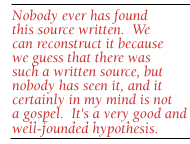Q - The Hypothetical Gospel
To explain a textual puzzle, scholars hypothesize a lost document - “Q.” It is known as the “secret sayings gospel.”The Harrington Spear Paine Foundation Professor of Religion Princeton University
 Today there are people who talk about Q as though it's a gospel. Q, as I see
it, is not a gospel, it's a hypothesis. When scholars first began to study
the gospels of the New Testament, literarily, they discovered that Matthew and
Luke both used Mark as the core, sort of the basic story line that they tell.
Because Mark is completely incorporated - 16 chapters - into both Matthew and
Luke. But they both also used other sayings, parables, and stories and so
forth. And scholars observed that there's a part of the sayings in Matthew
that are exactly identical with sayings in Luke. In fact they're identical in
Greek. Now think -- Jesus spoke Aramaic. So if you were translating Aramaic,
and if I were translating Aramaic, they'd come out different, these
translations. So you would only have Jesus speaking identical sayings in Greek
if you had a written translation in Greek of his sayings. And so scholars
suggested that there must have been, besides Mark, something else written down
that would have been a list of the sayings of Jesus, translated into Greek.
And they called that "Quelle" which means source in German. And they call it
for short, "Q." Nobody ever has found this source written. We can reconstruct
it because we guess that there was such a written source, but nobody has seen
it, and it certainly in my mind is not a gospel. It's a very good and
well-founded hypothesis.
Today there are people who talk about Q as though it's a gospel. Q, as I see
it, is not a gospel, it's a hypothesis. When scholars first began to study
the gospels of the New Testament, literarily, they discovered that Matthew and
Luke both used Mark as the core, sort of the basic story line that they tell.
Because Mark is completely incorporated - 16 chapters - into both Matthew and
Luke. But they both also used other sayings, parables, and stories and so
forth. And scholars observed that there's a part of the sayings in Matthew
that are exactly identical with sayings in Luke. In fact they're identical in
Greek. Now think -- Jesus spoke Aramaic. So if you were translating Aramaic,
and if I were translating Aramaic, they'd come out different, these
translations. So you would only have Jesus speaking identical sayings in Greek
if you had a written translation in Greek of his sayings. And so scholars
suggested that there must have been, besides Mark, something else written down
that would have been a list of the sayings of Jesus, translated into Greek.
And they called that "Quelle" which means source in German. And they call it
for short, "Q." Nobody ever has found this source written. We can reconstruct
it because we guess that there was such a written source, but nobody has seen
it, and it certainly in my mind is not a gospel. It's a very good and
well-founded hypothesis.
If it isn't gospel then what is it?
It was a source of the sayings of Jesus, and it's another picture of Jesus. For example, whoever collected the sayings of Q wasn't interested in the death of Jesus, wasn't interested in the resurrection of Jesus. They thought the importance of Jesus was what he said, what he preached. Now other people thought, "it's not enough to have the sayings of Jesus. You have to tell about his death and his crucifixion and his resurrection, that's the important thing." Now somebody put that all together and we call it Matthew, and we call it Mark, and we call it Luke. But originally these are probably rather distinct pictures.
![]()
Read more on Q in this essay by Marilyn Mellowes, and the Atlantic Monthly article The Search for a No-Frills Jesus.
